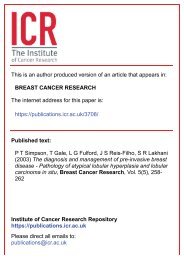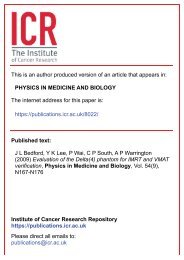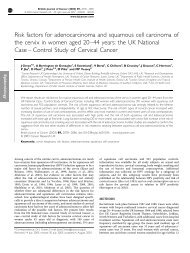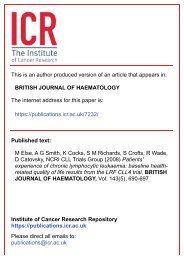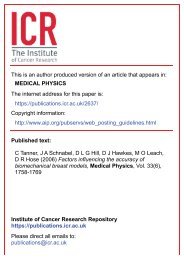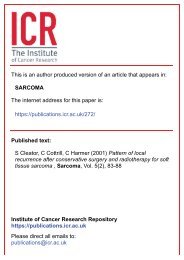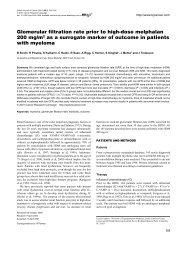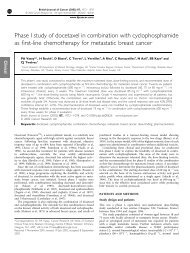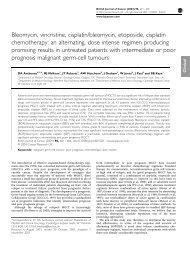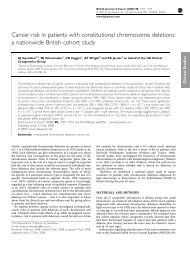Transcriptome analysis of mammary epithelial subpopulations ...
Transcriptome analysis of mammary epithelial subpopulations ...
Transcriptome analysis of mammary epithelial subpopulations ...
Create successful ePaper yourself
Turn your PDF publications into a flip-book with our unique Google optimized e-Paper software.
BMC Genomics 2008, 9:591http://www.biomedcentral.com/1471-2164/9/591DiscussionWe have described a comprehensive transcriptome <strong>analysis</strong><strong>of</strong> three distinct <strong>mammary</strong> <strong>epithelial</strong> cell populations,basal/myo<strong>epithelial</strong> cells, estrogen receptor negativeluminal <strong>epithelial</strong> cells and estrogen receptor positiveluminal <strong>epithelial</strong> cells [5,8]. These data provide new supportfor the distinct identities <strong>of</strong> these three populationsand, in particular, justify distinguishing between twomajor <strong>subpopulations</strong> within the luminal epithelium. Wehave termed these luminal ER - and luminal ER + cells as itis expression <strong>of</strong> the estrogen receptor which makes themmost easily distinguishable in tissue sections (Figure 1).However, each <strong>of</strong> them expresses, in addition, a largenumber <strong>of</strong> unique genes which must be <strong>of</strong> relevance totheir in vivo functions. It is also clear that there are genesin common to the two luminal populations but which arenot expressed by the myo<strong>epithelial</strong> cells. Expression <strong>of</strong>these genes, for cytoskeletal proteins (e.g. keratin 18) ortight junction components (e.g. claudins), for instance,must reflect common aspects <strong>of</strong> luminal <strong>epithelial</strong> cellfunction. Most obviously, they are for proteins importantin maintaining the structure <strong>of</strong> the luminal cell layer andthe integrity <strong>of</strong> the lumen itself.Comparison <strong>of</strong> our data set with other published data setsfor separated myo<strong>epithelial</strong> and luminal cells[6,26,27,29] showed good concordance between genespreviously identified as enriched in mouse <strong>mammary</strong>myo<strong>epithelial</strong> and luminal cells [6]. However, there wasless agreement with genes previously identified asenriched in human myo<strong>epithelial</strong> and luminal cells. Anumber <strong>of</strong> factors are likely to contribute to these differences.Clearly, species differences could be important. Forinstance, it is known that while K14 is a basal/myo<strong>epithelial</strong>cell marker and K18 a luminal <strong>epithelial</strong> cell markerthroughout the mouse <strong>mammary</strong> epithelium and in theducts <strong>of</strong> the human breast, in the Terminal Ductal LobuloalveolarUnits <strong>of</strong> the human breast, K14 can beexpressed by the luminal <strong>epithelial</strong> cells [63]. Furthermore,technical differences could influence the outcome<strong>of</strong> the analyses. In particular, it should be noted that Stingland colleagues used the same Affymetrix platform as ourselvesfor their mouse <strong>analysis</strong> [6]. Finally, comparingthree distinct populations against each other, rather thanjust two, improves the contrasts between the populationsand enables more population specific genes to bedetected. For example, a gene which is present in thebasal/myo<strong>epithelial</strong> cells and one <strong>of</strong> the luminal populations,but not the other, may not be detected as being significantlydifferentially expressed when onlymyo<strong>epithelial</strong> and total luminal cells are compared. However,when all three populations are compared againsteach other, the contrast with the luminal population fromwhich the gene is absent enables the differential expression<strong>of</strong> the gene to be detected.A novel functional cell type in the <strong>mammary</strong> epitheliumThe nature <strong>of</strong> the luminal ER - population as a discreteentity has been confirmed by its uniform staining pr<strong>of</strong>ilewith the 33A10 antibody [8]. However, this populationappeared to contain within it further distinct functionalcell types. Use <strong>of</strong> network interaction mapping on thetranscriptomic pr<strong>of</strong>iles <strong>of</strong> the luminal ER - cells identifieda Toll-like receptor (TLR) signalling module includinggenes for the three components <strong>of</strong> the bacterial lipopolysaccharide(LPS) receptor, Tlr4, CD14 and Ly96, as well asdownstream transducers <strong>of</strong> Toll-like receptor signallingsuch as Irak2 and the pro-inflammatory cytokine Tnf,which is a TLR signalling target [38] (Figure 4 and 5). Flowcytometric <strong>analysis</strong> <strong>of</strong> the <strong>mammary</strong> epithelium usinganti-CD14 and anti-CD61 (a <strong>mammary</strong> progenitor cellmarker) [11] identified a small number <strong>of</strong> CD61 + cells inthe CD24 +/Low Sca-1 - basal population and four distinct<strong>subpopulations</strong> within the luminal ER - cells, namelyCD61 + , CD61 + CD14 + , CD14 + and double negative cells.This raises the possibility <strong>of</strong> a differentiation hierarchy inwhich basal stem cells generate basal CD61 + progenitorswhich then become CD61 + progenitors with luminalcharacteristics. These then either lose CD61 + and becomethe double negative cells (although presumably expressingother markers as yet undefined) or first acquire CD14expression, becoming CD61 + CD14 + progenitors, andthen lose CD61 expression to become the CD14 + population.If this hypothesis is correct, it suggests that the luminalER - population contains two distinct functional celltypes, the double negative cells and the CD14 + cells.The function <strong>of</strong> the double negative cells remains unclear.However, given that the expression <strong>of</strong> all components <strong>of</strong>the LPS receptor can be found in the luminal ER - population,it is likely that the CD14 + cells have a distinct functionwithin the <strong>mammary</strong> epithelium as non-pr<strong>of</strong>essionalimmune cells. Note that CD45 + cells were excluded fromthis <strong>analysis</strong>, so these are unlikely to be contaminatinghaematopoietic cells. Milk is an excellent growth mediumfor bacteria and it would be evolutionarily advantageousto have a cell type present in the breast capable <strong>of</strong> indicatingthe presence <strong>of</strong> bacterial contamination through Tolllikereceptor signalling pathways. However, it is also likelythat over-stimulation <strong>of</strong> this pathway in CD14 + <strong>mammary</strong><strong>epithelial</strong> cells would lead to serious inflammation andwould therefore be the cause <strong>of</strong> mastitis.The presence <strong>of</strong> the distinct <strong>subpopulations</strong> within theluminal ER - cells indicates that the gene expression pr<strong>of</strong>ile<strong>of</strong> this population is derived from a mixture <strong>of</strong> differentcell types. However, as the luminal ER - cells do all share atleast one distinctive marker (high levels <strong>of</strong> expression <strong>of</strong>the epitope bound by the 33A10 antibody) [8] it is likelythat the luminal ER - pr<strong>of</strong>ile includes genes whose expressionis common to all the cells <strong>of</strong> this subpopulation, asPage 18 <strong>of</strong> 28(page number not for citation purposes)



